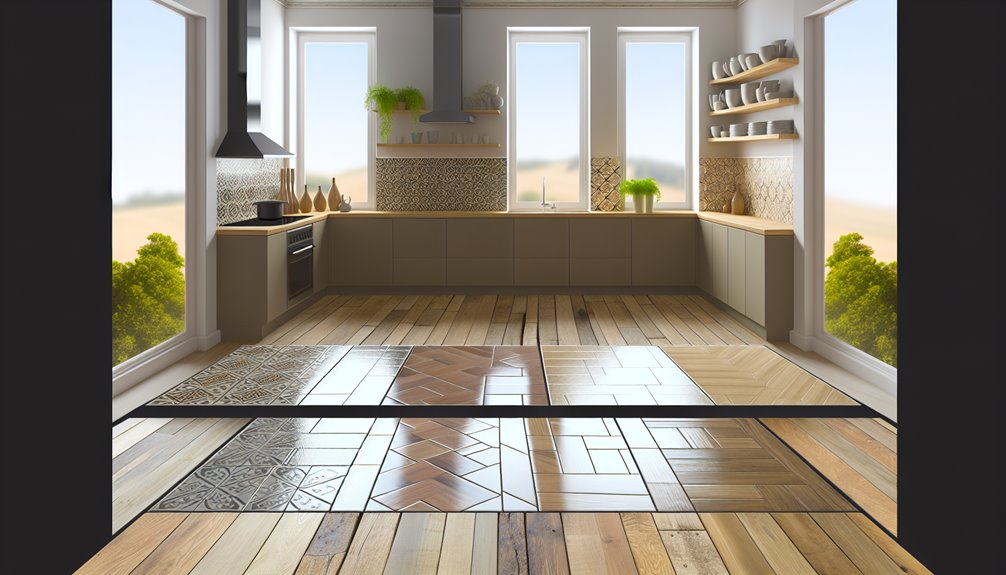For an appealing kitchen shift from tiles to wood flooring, consider using transition strips for a clean finish. Adding patterned borders can enhance visual interest, while a gradual color change promotes harmony between materials. Incorporating a threshold adds dimension and guides the eye smoothly. Finally, experimenting with different tile shapes and sizes can introduce unique design elements. Explore these ideas further to elevate your kitchen’s aesthetic and functionality.
Key Takeaways
- Use a transition strip to create a seamless connection between kitchen tiles and wood flooring for a polished finish.
- Design a patterned border with tiles to define the transition using geometric patterns and contrasting colors for visual appeal.
- Opt for a gradual color change to mimic undertones of wood, enhancing harmony and cohesion between materials.
- Incorporate a threshold to introduce dimension, guiding the eye and enriching the overall design of the kitchen.
- Experiment with different tile shapes and sizes to add depth, contrast, and visual interest to the floor transition.
Use a Transition Strip for a Clean Finish
A changeover strip serves as a practical solution for achieving a seamless connection between kitchen tiles and wood flooring. This essential accessory not only enhances the aesthetic appeal but also provides a functional barrier that prevents moisture penetration.
Changeover strip materials vary, including wood, metal, and vinyl, allowing homeowners to select the best option that aligns with their interior design. When installed correctly, these strips facilitate a smooth changeover, effectively bridging the height difference between the two surfaces.
Utilizing seamless installation techniques, such as precise cutting and secure fastening, guarantees a polished finish. By choosing the appropriate changeover strip and employing these methods, one can achieve a clean and professional look that enhances the overall harmony of the kitchen space.
Create a Patterned Border With Tiles
Transforming the shift between kitchen tiles and wood flooring can be achieved by creating a patterned border with tiles. This technique not only defines the change but also adds a decorative element. By incorporating geometric patterns and contrasting colors, homeowners can make the transition visually appealing. For instance, a border of small, colorful tiles can outline the edge of the wood floor, creating a stunning focal point. Below is a table highlighting some popular geometric patterns and color combinations to take into account:
| Geometric Pattern | Contrasting Color Combination |
|---|---|
| Herringbone | Navy Blue and White |
| Chevron | Black and Gold |
| Hexagonal | Gray and Yellow |
| Diamond | Red and Cream |
| Basketweave | Teal and Beige |
This approach guarantees an elegant and cohesive look.
Opt for a Gradual Color Change
Creating a patterned border with tiles offers one way to enhance the changeover between kitchen tiles and wood flooring.
However, opting for a gradual color change is another effective approach. By selecting a color palette that shifts smoothly from the hues of the tiles to the wood floor, homeowners can achieve visual harmony.
For instance, choosing tiles in shades that mimic the undertones of the wood creates a seamless flow. This technique not only softens the contrast but also establishes a cohesive look throughout the space.
Gradual color changes can be achieved through various methods, such as ombre effects or using tiles that incorporate multiple shades.
This thoughtful alteration enhances both aesthetics and functionality in kitchen design.
Incorporate a Threshold for Added Dimension
Incorporating a threshold between kitchen tiles and wood flooring introduces an element of dimension that can enhance the overall design. By selecting appropriate threshold styles, homeowners can create a visually appealing connection that emphasizes the distinct characteristics of each flooring type.
For instance, a sleek metal threshold can provide a modern touch, while a wooden threshold can complement the warmth of the wood floor. These choices create dimensional contrasts that not only serve a functional purpose but also add aesthetic value.
Additionally, thresholds can help define spaces, guiding the eye seamlessly from one area to another. Ultimately, investing in a well-chosen threshold enriches the kitchen’s design, making the connection between tiles and wood both stylish and practical.
Experiment With Different Tile Shapes and Sizes
Exploring various tile shapes and sizes can greatly enhance the aesthetic appeal of the kitchen floor. By incorporating unique tile shapes, such as hexagons or triangles, homeowners can create visually striking patterns that draw the eye. Additionally, mixing different tile sizes can introduce depth and contrast, making the shift to wood flooring more dynamic.
| Tile Shape | Description |
|---|---|
| Square | Classic and versatile |
| Rectangular | Ideal for a modern look |
| Hexagonal | Adds geometric interest |
| Triangular | Unique and playful designs |
| Irregular | Perfect for a rustic vibe |
Experimenting with these tile shapes and sizes allows for personalized design solutions that complement the overall kitchen theme, ensuring a cohesive shift to wood flooring.



